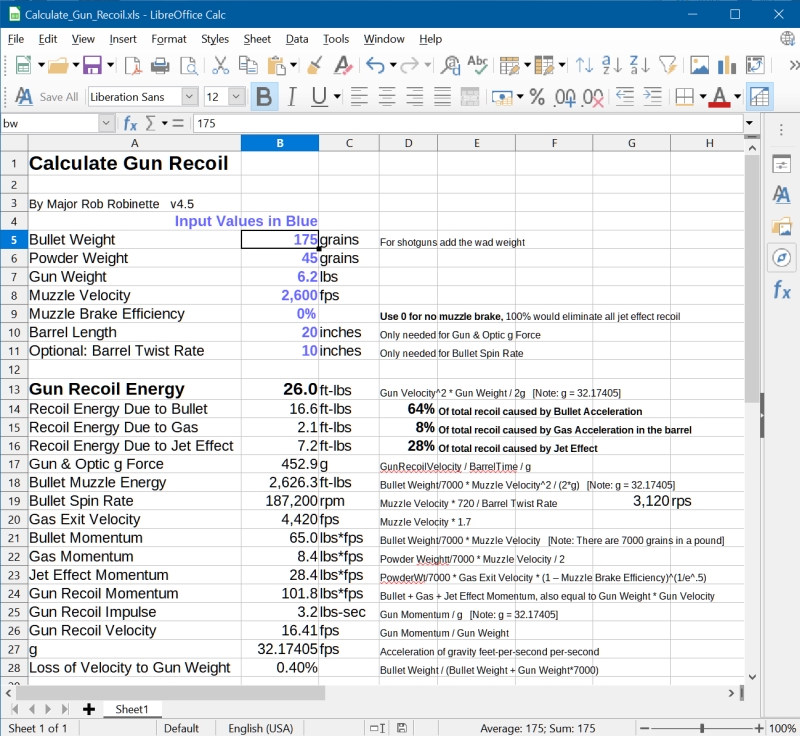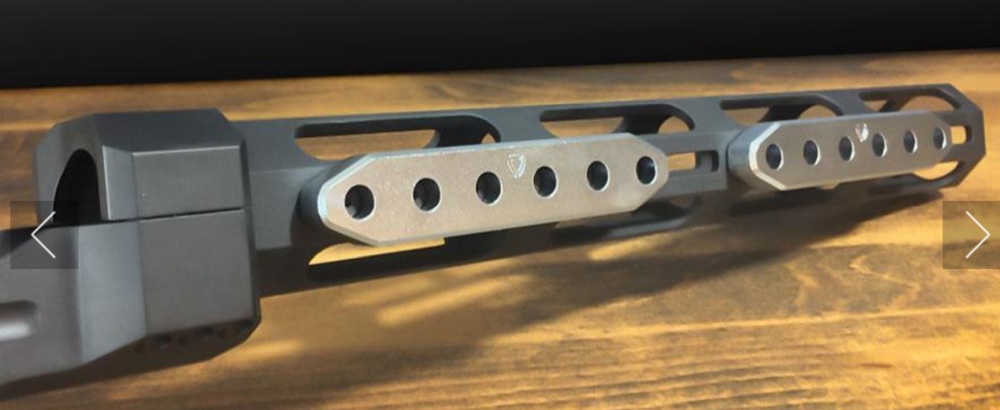Gun Recoil Calculator
By Major Rob Robinette
Enter the following five values and click the Calculate button:
Examples to Try
6.5 Creedmoor: 6.2 lbs rifle, 147 gr bullet, 39 gr powder, 2600 fps, 0% muzzle brake
.700 Nitro Express Dangerous Game Rifle: 18 lbs rifle, 1000 gr bullet, 160 gr powder, 2000 fps, 0% muzzle brake
6.5 Creedmoor AR10 Rifle: 8.5 lbs, 147 gr bullet, 39 gr powder, 2560 fps, 0% muzzle brake
Barret Model 82A1 50BMG Rifle: 32.7 lbs, 655 gr bullet, 248 gr powder, 3029 fps, 90% muzzle brake
US Army M4 5.56 Rifle & M193 ball ammo: 6.5 lbs, 56 gr bullet, 27.5 gr powder, 3250 fps, 10% muzzle brake (flash hider)
22LR rifle: 6 lbs, 40 gr bullet, 2.5 gr powder, 1185 fps, 0% muzzle brake
12 gauge shotgun: 7 lbs, firing 2 3/4 inch shot shell with 1 3/8 ounces of shot (multiply ounces by 437.5 to convert to grains, so 601.6 grains + 20 grain wad = 621.6), 35.5 gr powder at 1310 fps, 0% muzzle brake
Glock 17 full size 9mm pistol: 2 lbs (fully loaded), 115 gr bullet, 6 gr powder, 1050 fps, 0% muzzle brake
S&W Model 340 PD Airlight 357 Mag Revolver: 0.74 lb, 158 gr bullet, 13 gr powder, 1115 fps, 0% muzzle brake
Same S&W Model 340 PD Airlight 357 Mag Revolver shooting 38 Special: 158 gr bullet, 4.5 gr powder, 640 fps, 0% muzzle brake
S&W Model 686 Plus 357 Mag Revolver: 2.3 lbs, 158 gr bullet, 13 gr powder, 1115 fps (same load as the Airlight above)
S&W Model 500 8 inch 50S&W Revolver: 4.46 lbs, 700 gr bullet, 27.5 gr powder, 1300 fps, 40% muzzle brake
Same S&W 500 with 275 gr bullet with 40 gr powder, 1804 fps
308 Win Rifle is the default gun, just refresh your browser to load the .308 rifle numbers
When I began studying weapon recoil I was surprised to find most of the mathematical theory was from the early 1900's. The formulas from these early texts are still in common use today, but they do not jive with current muzzle brake research. Classic recoil formulas greatly underestimate the recoil generated by the exit gas from the muzzle or the "jet effect". Like uncorking Champaign, when a bullet clears the muzzle, gas accelerates and shoots past the bullet. This acceleration of gas out of the muzzle is called the "jet effect", and accounts for approximately 10 to 55% of total recoil energy.
PrecisionRifleBlog.com did an excellent series of articles on muzzle brake effectiveness. The graphs below from these articles show how much force is generated by the jet effect.
PrecisionRifleBlog.com Recoil Force Charts
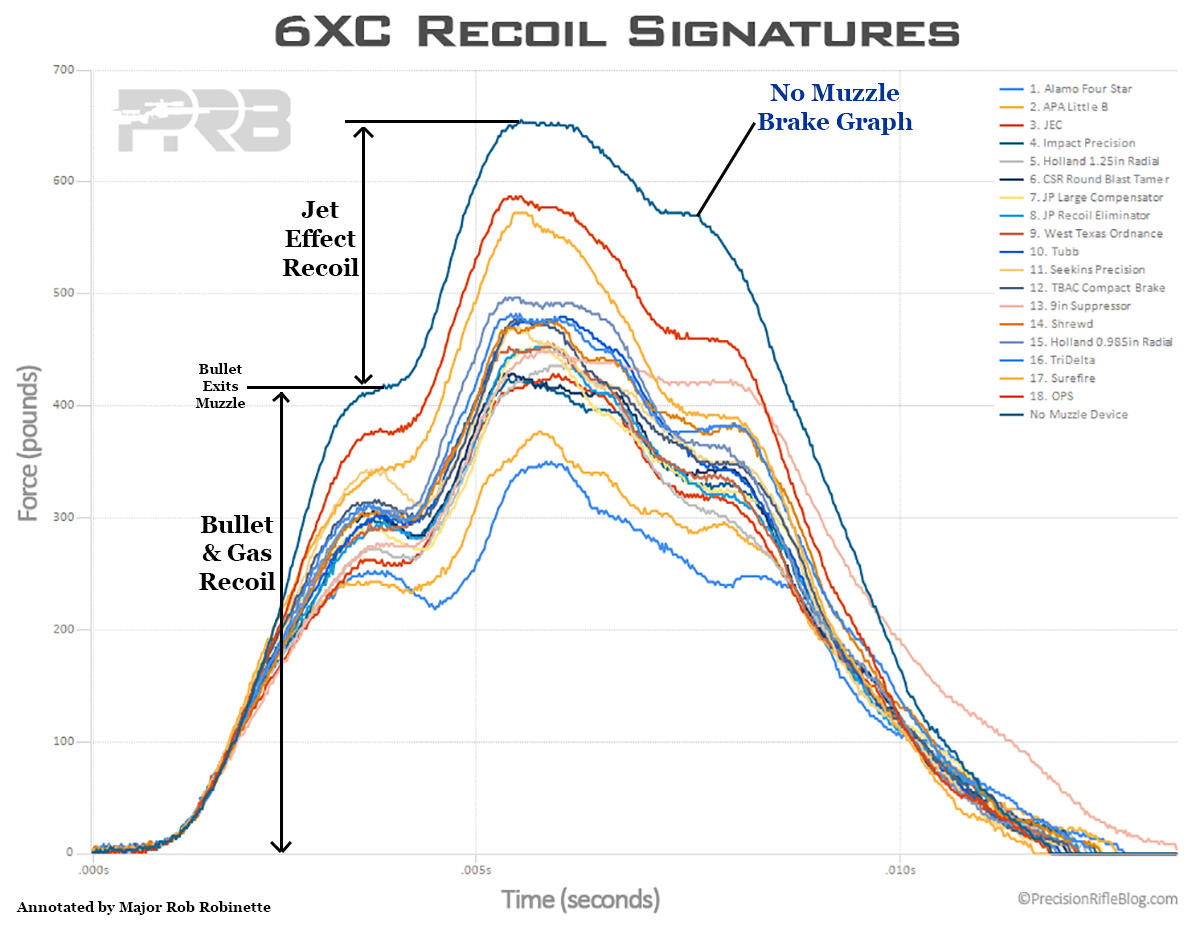
The top blue graph line is recoil force without a muzzle brake. Notice how recoil levels off at 420 pounds when the bullet exits the muzzle. After bullet exit the force jumps to 655 pounds as exit gas blows out of the muzzle. This shows that for the 6XC cartridge in this gun, approximately 36% of recoil force is from the exit gas jet effect [(655-420) / 655 = .36]. This chart is from the PrecisionRifleBlog.com muzzle brake test article with annotations added.
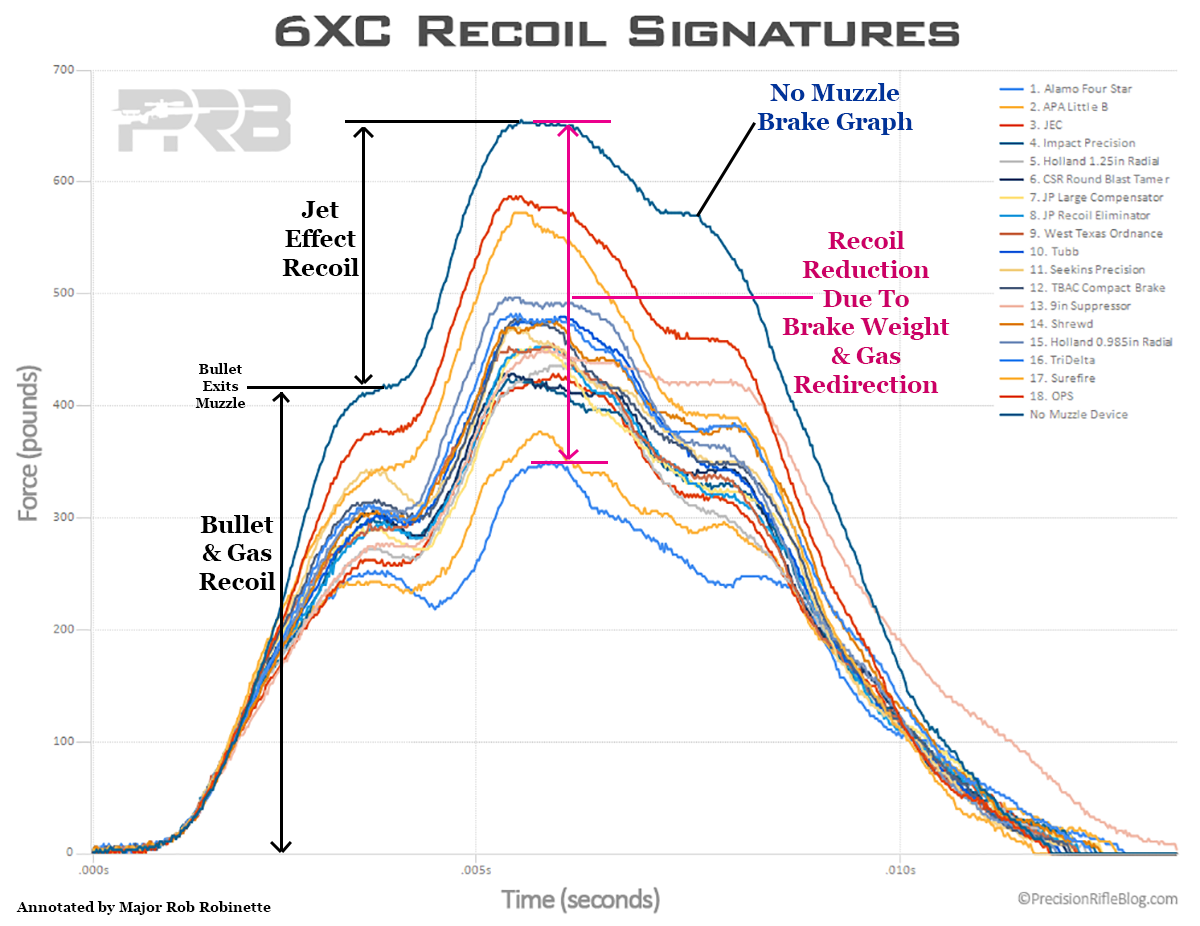
The reduction in recoil highlighted in magenta above is due to a combination of the muzzle brake weight and muzzle brake exit gas redirection.
Arms and Explosives (1909, page 20) used a constant velocity of 3200 feet-per-second for gas muzzle exit velocity. I believe this "constant" is wholly antiquated when used with today's high efficiency smokeless gun powders. Instead of using a constant I have found a more accurate estimate of muzzle gas velocity is bullet muzzle velocity * 1.7. Adding this to the classic formula brings calculated recoil much closer to modern recoil measurements and muzzle brake tests. You can see in this super slow motion film gas shoots past the bullet exiting the muzzle. This acceleration out of the muzzle causes jet effect recoil.
Super Slow Motion Bullet Muzzle Exit
Note how much faster the gasses exiting the muzzle are compared to the bullet.
Gun recoil momentum and energy are generated in three ways:
1. The acceleration of the bullet in the barrel.
Bullet Momentum is equal to: Bullet Weight * Muzzle Velocity
Bullet Energy is equal to: Bullet Weight * Muzzle Velocity squared / 2g [g is the acceleration of gravity feet-per-second per-second and is equal to 32.17405]
An equal and opposite reaction to the bullet acceleration is transferred to the gun.
2. The acceleration of the powder burn gasses inside the barrel.
Gas Momentum is equal to: Powder Weight * Muzzle Velocity / 2
We use the powder weight because the gas created when the powder burns is equal to the powder weight.
An equal and opposite reaction to the gas acceleration is transferred to the gun.
We divide the muzzle velocity by 2 because as the bullet moves from breech to muzzle, the powder's center of gravity only moves from the breech to the center of the barrel when the bullet exits the muzzle.
3. The "jet effect" of the powder burn gasses exiting the muzzle.
Jet Effect Momentum is approximately equal to: Powder Weight * Muzzle Velocity * 1.7
When a muzzle brake is used, Jet Effect Momentum = Powder Weight * Muzzle Velocity * 1.7 * (1 – Muzzle Brake Efficiency)^(1/√℮)
Gas exit velocity is estimated at: 1.7 * bullet muzzle velocity.
An equal and opposite reaction to the jet effect is transferred to the gun.
When a bullet clears the muzzle, gas accelerates and shoots past the bullet. This force is what a muzzle brake acts upon. A brake's additional weight will also reduce recoil energy (but the additional weight does not affect gun recoil momentum).
Jet Effect Momentum Formula

GasExitVelocity = MuzzleVelocity * 1.7
Gun Recoil Momentum, Impulse, Velocity and Energy

Also
![]()
Gun Recoil Impulse Formula

g = acceleration of gravity feet-per-second per-second = 32.17405
Impulse = ChangeInMomentum = AverageForce * ElapsedTime
Gun Recoil Velocity Formulas



Gun Recoil Energy Formula

g = acceleration of gravity feet-per-second per-second = 32.17405, 2g = 64.35
The above equations assume all powder is burned inside the barrel. A slow burning powder that doesn't completely burn inside the barrel can greatly reduce bullet velocity and recoil because unburned powder imparts no energy to the bullet and has no jet effect. I use QuickLOAD, an internal ballistics program, to select powders that will burn completely in a given barrel length.
Gun & Optic g Force

Gun & Optic g Force tells us how hard our scope will be hit during recoil. The g force calculated with the above formula is what the firearm would feel if shot while hanging from strings, or free recoil. When we shoulder a rifle or hold a pistol, some of our body weight is added to the effective gun weight, so the more securely we hold a firearm, the less g force the gun and optic will actually feel. We calculate the recoil velocity of the gun and divide it by the time the bullet is accelerating inside the barrel, which gives us acceleration in feet-per-second. We then divide that acceleration by g to get the number of g's the rifle and optic experience.
GunVelocity = (BulletMomentum + GasMomentum) / GunWeight
When calculating GunVelocity I leave out JetEffectMomentum and just use BulletMomentum + GasMomentum. I do this because the highest recoil impulse will come during early bullet acceleration and we can calculate exactly how much time the bullet is in the barrel so we can ignore what happens after the bullet leaves the barrel.
Bullet Acceleration Inside Barrel
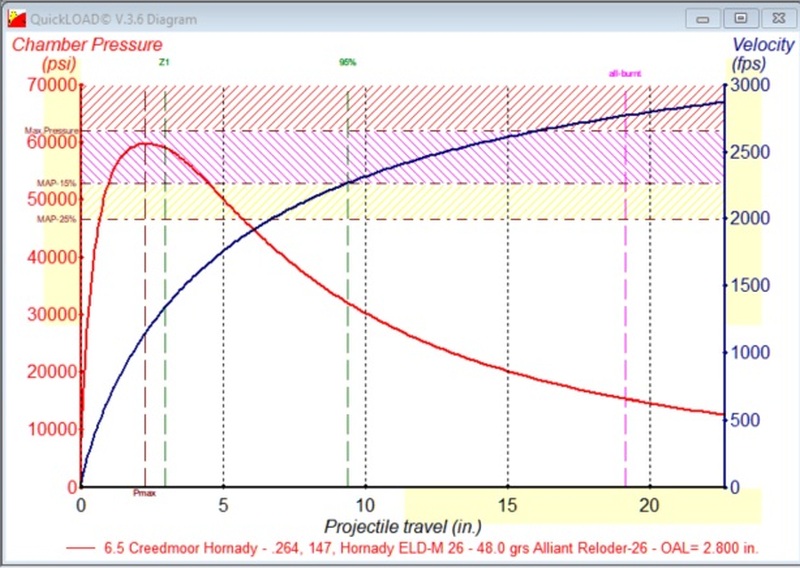
The blue line shows bullet speed in fps (right scale) inside a 22" 6.5 Creedmoor barrel. The bullet reaches 50% of muzzle velocity after only 2.6 inches of travel. The slope of the blue line corresponds to acceleration. The steeper the slope, the quicker the acceleration and the higher the g. The graph was created using QuickLOAD internal ballistics software.
We can calculate precisely how long the bullet is in the barrel by dividing BarrelLength by the average speed of the bullet in the barrel. I subtract 1 inch from barrel length because manufacturer barrel length includes the chamber. The barrel length is then converted to feet and MuzzleVelocity is in feet-per-second. Bullets initially accelerate very fast in the barrel so their average speed through the barrel is about 60% of MuzzleVelocity.
BarrelTime = BarrelLength / (MuzzleVelocity * 0.6)
After dividing GunVelocity by BarrelTime we divide the resulting acceleration by g, which is the acceleration of gravity. The value of g is a constant equal to 32.17405 feet-per-second per-second. The result is the number of g's the gun and optic experience when hanging from strings and fired, but will be lower when fired from the shoulder or held securely in the hands. The more firmly a firearm is held, the lower the g felt by the firearm and optic. If we clamp a firearm into a large vise and fire it, the gun and optic will feel no acceleration and no g. My old F-15 Eagle fighter could keep me at 9g for a couple of minutes but optics routinely take over 500g's when bolted to a light and powerful gun.
Relationship of Gun Weight To Muzzle Velocity

A heavier gun will give us slightly higher muzzle velocity.
Work is calculated by multiplying force by the distance over which that force is applied. Consider this thought experiment: The gun and bullet both weigh 1 pound. This formula says the loss of velocity to gun weight = 1 / (1+1) = 0.5 so 50% of the energy from the expanding propellant gas is used to propel the gun, and 50% propels the bullet, so the bullet and gun will have the same velocity, If the gun were placed against an immovable wall, the gun weight is equivalent to infinity and loss of velocity to gun weight = 0, so all the energy of the propellant is used to push the bullet, and muzzle velocity doubles. There are 7000 grains in a pound, so for an 8 pound rifle firing a 200 grain bullet the formula is: loss of velocity = 200 / (8*7000 + 200) = 0.4% loss, so 99.6% of the work done by the expanding gas is applied to the bullet and 0.4% to the rifle.
Now let's look at a very light pistol, the 0.74 lb S&W 340 PD Airlight 357 Magnum, firing a 200 grain bullet: 200 / (0.74 * 7000 + 200) = 3.7% loss, so even at the extreme, gun weight has little effect on muzzle velocity. If muzzle velocity is 800 fps with the pistol clamped down, then we'd lose only 30 fps to 770 fps when fired hanging from strings (free recoil). A firm, strong grip on the pistol will cut that velocity loss because it increases the effective weight of the pistol.
Gun Recoil Calculation Spreadsheet
If you prefer using a spreadsheet then download the Excel Gun Recoil Calculation Spreadsheet or the LibreOffice Spreadsheet.
Recoil Basics
All other things being equal, a lighter gun will have more recoil energy. The Smith & Wesson Model 340 PD 357 Mag revolver with a 2 inch barrel and made of Scandium and Titanium, is extremely light at 0.74 lb. It kicks like a mule when firing heavy 357 Mag bullets. Plug in these numbers in the recoil calculator above: 158 gr bullet, 13 gr of powder, 0.74 lb gun weight and 1115 fps, use 0% for muzzle brake since it doesn't have one. That gives us a very stout 18.6 ft-lbs of recoil energy from this "Airlight" pistol. Fire the same exact load from the S&W Model 686 Plus, which weighs 2.3 lbs, and the recoil energy drops to a very manageable 6.0 ft-lbs, a 68% reduction in recoil energy due solely to the extra pistol weight.
S&W's 357 Magnum Airlight pistols are so light their recoil energy noticeably increases as you empty the gun. Four 158gr 357 Magnum cartridges weigh approximately 0.12 lbs (the 340 PD holds five rounds but one is being fired in this example). For the first shot the pistol + 4 cartridges weigh 0.74 + 0.12 = 0.86 lb which gives us 16.0 ft-lbs of recoil energy, compared to the last shot at 18.6 ft-lbs for a 16% increase in recoil energy.
The 8 inch barreled S&W 500 50 caliber pistol weighs in at 4.46 lbs and fires a 700 gr bullet at 1300 fps using 27.5 gr of powder. I estimate its barrel ports at 40% efficient as a muzzle brake. Plug those numbers into the calculator above and we get an amazing 67 ft-lbs of recoil energy! The same exact pistol firing a 275 gr bullet with 40 gr of powder will give us 1804 fps of muzzle velocity with a recoil energy of "just" 28 ft-lbs.
The US Army's M4 rifle using M193 ball ammunition comes in at 6.5 lbs, 56 gr bullet at 3050 fps using 27.5 gr of powder and a 10% efficient muzzle brake (flash hider) with a paltry 5.9 ft-lbs of recoil energy.
A 6 lb .22 rifle using a 22LR cartridge: 40 gr bullet, 2.5 gr powder at 1185 fps, no muzzle brake, hits us with 0.17 lb of recoil energy!
When I fire my 20 lb Serbu BFG-50 50BMG rifle with a typical 50 cal round, 655 gr bullet, 248 gr powder at 3029 fps, with the muzzle brake removed it generates a whooping 210 ft-lbs of recoil energy. That's why it has a big muzzle brake. Assuming the muzzle brake weighs 1 lb and is 90% efficient, the recoil energy drops to 114 ft-lbs (46% less recoil) which is still a serious kick in the shoulder.
A 7 lb 12 gauge shotgun firing 2 3/4 inch shot shell with 1 3/8 ounces of shot (multiply ounces by 437.5 to convert to grains, so 601.6 grains + 20 grain wad = 621.6), 35.5 gr powder at 1310 fps and no muzzle brake gives us 38 ft-lbs or recoil energy.
I added a pair of these XLR Industries M-LOC Steel Chassis Weights to my Tikka T3x TAC A1 and 6.5mm Ruger Precision Rifle. Adding a pair at 15 total ounces will reduce the Tikka and 6.5 Creedmoor Ruger Precision Rifle's recoil energy by 8%. The 6.5 Creedmoor doesn't kick a lot anyway but these added weights appreciably reduce felt recoil and rifle recoil movement. Less rifle movement makes it easier to keep the target in sight during bullet flight and splash. They're easy to remove if you want to take the rifle hunting. If you want a dual-purpose long range rifle for hunting and target shooting I recommend a carbon fiber wrapped barrel for light weight hunting, then add one or two pair of these chassis weights for target shooting.
Chassis Weights
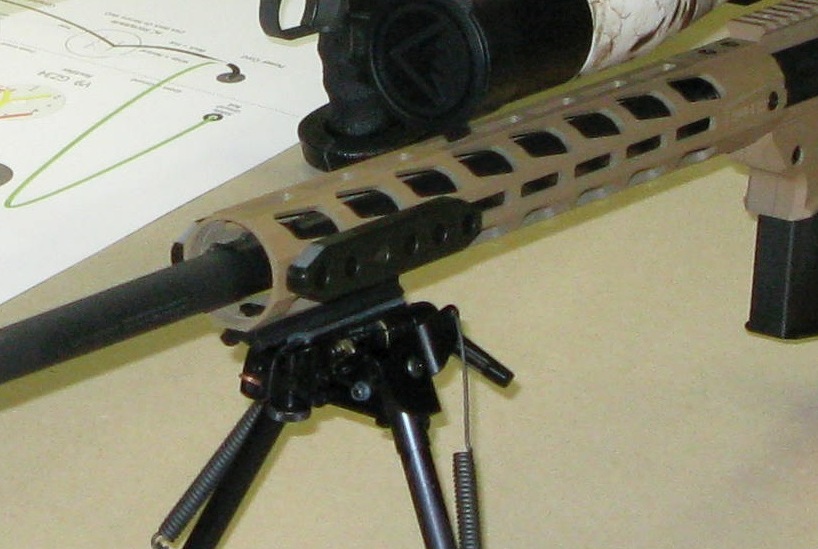
XLR Industries M-LOC Steel Chassis Weights mounted on a Ruger Precision Rifle reduce felt recoil and rifle movement. A set of two add 15 ounces (15/16 pound) and cost $89.
All other things being equal, a faster burning powder will generate a "sharper" or "snappier" recoil with a higher peak energy. This can be caused by two factors: more of the powder is burned in the barrel generating more energy and the quicker we accelerate the bullet in the barrel the shorter the recoil energy impulse.
Peak recoil energy plays a major part in our perception of recoil. The more secure a gun is when it is fired, the higher the peak recoil energy. A gun mounted in a vise will show a much higher peak energy compared to the same gun fired from the shoulder when standing because the shoulder will move and spread the recoil over a longer time period. The same recoil energy is absorbed by the vice and shoulder but the time in which it is absorbed affects the energy peak. This is why using a "lead sled" can crack a wooden stock and why modern artillery has "shock absorbers" which allow the barrel to move in recoil.
The AR-15 bolt buffer works by spreading the bolt recoil impulse over time. When the bolt strikes the buffer it transfers its recoil momentum to the buffer then the buffer spring spreads the buffer recoil energy over time. The bolt recoil energy isn't reduced but it is spread out so felt shoulder recoil isn't as "sharp" and perceived recoil is reduced.
Pistols use much less powder than rifles therefore they generate less gas and jet effect recoil. Less jet effect recoil means a muzzle brake or compensator will have less effect.
All other things being equal, heavier pistol bullets strike high due to more recoil & more muzzle jump.
A shorter barrel can result in higher muzzle pressure and therefore more jet effect. A shorter barrel also reduces weight which also adds to gun recoil velocity and recoil energy.
Jet effect recoil becomes more prominent with the use of high velocity lightweight bullets. Lightweight bullets generate less recoil but the jet effect is the same so it becomes a higher percentage of total recoil energy.
A note about momentum versus energy: Momentum is calculated by simply multiplying weight x velocity whereas energy is velocity squared x weight / 2g [g is the acceleration of gravity feet-per-second per-second and 2g is equal to 64.35 fps-ps]. Squaring velocity means energy is more affected by velocity--the relationship between energy and velocity is nonlinear so it's not quite as intuitive as momentum. If we double the velocity we don't double the energy, it is quadrupled.
A 100 grain bullet with a muzzle velocity of 1000 fps has a momentum of 14.3 and 222 ft-lbs of energy
A 100 grain bullet with a muzzle velocity of 2000 fps has a momentum of 28.6 and 888 ft-lbs of energy
With double the velocity the momentum doubles but the energy quadruples. This is why lightweight but high velocity bullets do so much damage and one of the reasons the US Army adopted the 5.56 cartridge for the M16.
Recoil Versus Bullet Weight
Bullet muzzle energy is equal to:

We can see from the formula that since muzzle velocity is squared it will have more effect on energy than bullet weight.
Let's compare the recoil from two loads with the same muzzle energy but different weight bullets fired from 7 lb rifles:
34 grain 22-250 bullet with 38 grains of powder at 4500 fps muzzle velocity and 80% effective muzzle brake has 1529 ft-lbs of muzzle energy and hits the shooter with 5.5 ft-lbs of recoil energy.
300 grain 338 Win Mag bullet with 40 grains of powder at 1515 muzzle velocity and 80% effective muzzle brake has the same 1529 ft-lbs of muzzle energy but hits the shooter with 12.4 ft-lbs of recoil energy--125% more recoil than the 22-250!
Note both have 1529 ft-lbs of muzzle energy, but the lighter and faster bullet causes much less recoil at the same muzzle energy. This is why light weight, high velocity calibers are popular with recoil sensitive shooters and is another reason the US Army chose 5.56 for the M16 rifle.
Muzzle Brakes
Muzzle brakes are designed to reduce recoil force by redirecting exit gas and minimizing the jet effect, but their additional weight also reduces recoil energy. Adding an 8oz (half pound) muzzle brake to a 6.2 pound 308 rifle reduces its recoil energy by 7.4% due solely to the added weight. The best muzzle brake in the PrecisionRifleBlog test was the Alamo Four Star (now called MPA Cowl Induction Brake) weighs in at 6 oz and would reduce recoil energy on the same rifle by 5.6% due to added weight.
All other things being equal, the lighter the gun, the higher the recoil energy and the more effective a muzzle brake becomes.
Typically, the more powerful the gun, the more effective a muzzle brake becomes. This is why all 50BMG rifles have large muzzle brakes.
Since muzzle brakes are designed to reduce jet effect recoil, pistol muzzle brakes are less effective due to the small amount of gun powder (and therefore gas) used in pistols. But their added weight can reduce recoil significantly. Adding a half-pound muzzle brake to a 2 pound pistol will cut recoil energy by 20% due solely to the added weight.
Surprisingly, the PrecisionRifleBlog muzzle brake test found that using the correct caliber muzzle brake isn't that important. Shooting 6mm through a 7.62mm muzzle brake was only 1 to 3% less effective in reducing recoil compared to the same brake in 6mm.
“The Johnson muzzle brake. This reduces recoil from forty to fifty percent by actual test”, Hatcher’s Notebook p269. PrecisionRifleBlog.com muzzle brake tests show a similar maximum recoil momentum reduction of 44%. Since recoil momentum is not affected by weight we know all 44% of this recoil reduction is from redirected exit gas.
PrecisionRifleBlog.com Muzzle Brake Comparison

The top blue graph line is recoil force without a muzzle brake. Notice how recoil levels off at 420 pounds when the bullet exits the muzzle. After bullet exit the force jumps to 655 pounds as exit gas blows out of the muzzle. In this graph 36% of recoil energy is caused by the jet effect. This graph is from the PrecisionRifleBlog.com muzzle brake test article with annotations added.
Even with a perfectly designed muzzle brake there will be exit gas that will escape through the brake's bore hole. Even so, theoretically a muzzle brake can be more than 100% efficient if it can send enough exit gas rearward to make up for the gas that escapes through the bore hole. Any exit gas that turns more than 90 degrees from the bore axis (rearward) will actually produce force opposite the recoil (forward thrust).
Suppressors
A good suppressor or "silencer" is typically about 50% as effective in reducing rifle recoil momentum compared to a good muzzle brake. Some new suppressor designs have the last chamber ported out the side of the suppressor. Other new designs actually add a muzzle brake to the suppressor exit. This can significantly reduce recoil. Pistol cartridges use relatively small amounts of powder and therefore generate less jet effect gas than rifles, so pistol suppressors have less gas to work with and only reduce recoil by approximately 5 to 10%.
The added weight of a suppressor also reduces recoil. Since pistols are light, the additional weight of a suppressor can greatly reduce their recoil. The weight of a SilencerCO Osprey 45 ACP suppressor (0.65lb) installed on a fully loaded Glock 21 (full size 45 ACP at 2.47lb) will cut recoil energy by 21% due to the added suppressor weight. The same suppressor installed on a Glock 17 with empty magazine (full size 9mm at 1.55lb) will cut recoil energy by 30% due to weight alone. Total suppressor recoil reduction from gas redirection and added weight usually comes in around 25% for pistols and 15 to 40% for rifles.
A pistol suppressor also reduces muzzle flip by making the weapon longer, which spreads its weight over a greater length, increasing its moment of inertia, thereby reducing rotation (muzzle flip is a rotational force).
A suppressed pistol with a red dot sight can be frighteningly accurate. Less noise, less recoil, less muzzle flip and a sighting system that can take advantage it.
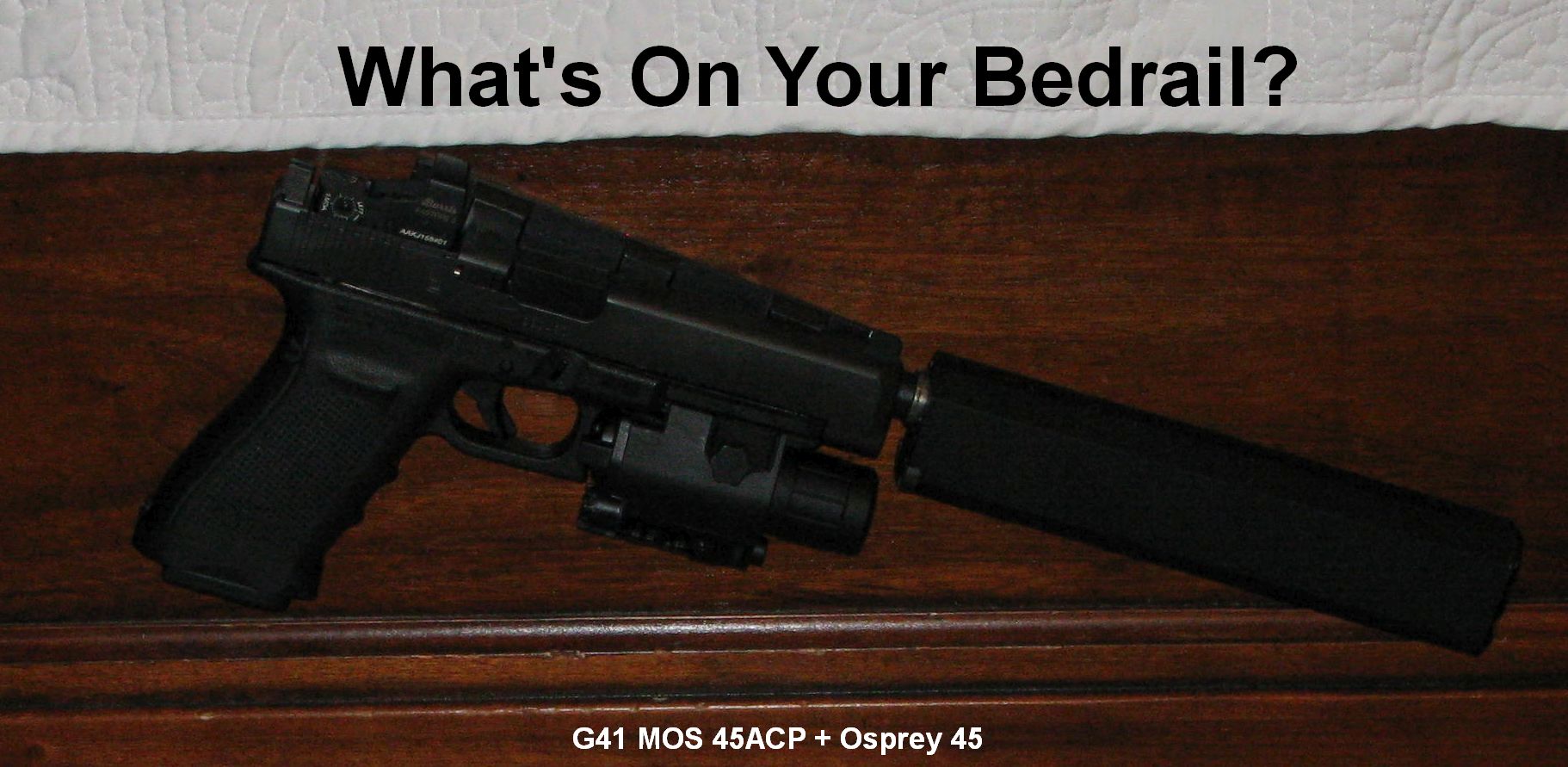
Super Slow Motion Firing Sequences
The following stills were captured from the Slow Mo Guys "Bullet Racing" YouTube video.
45ACP
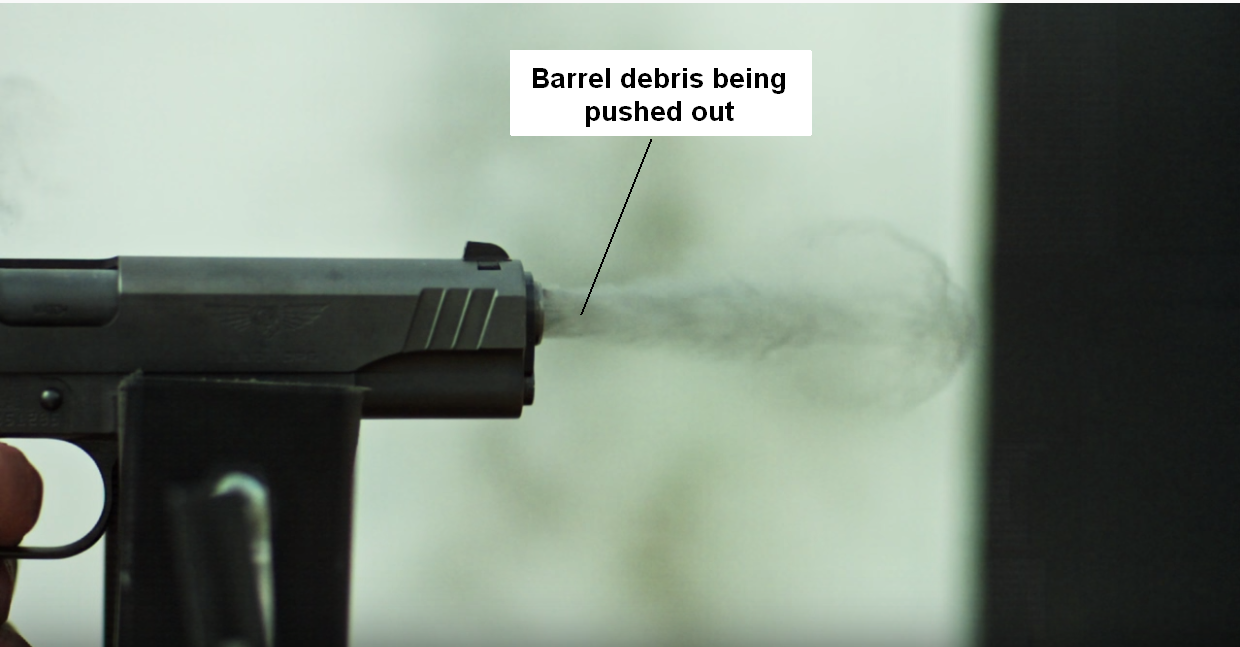
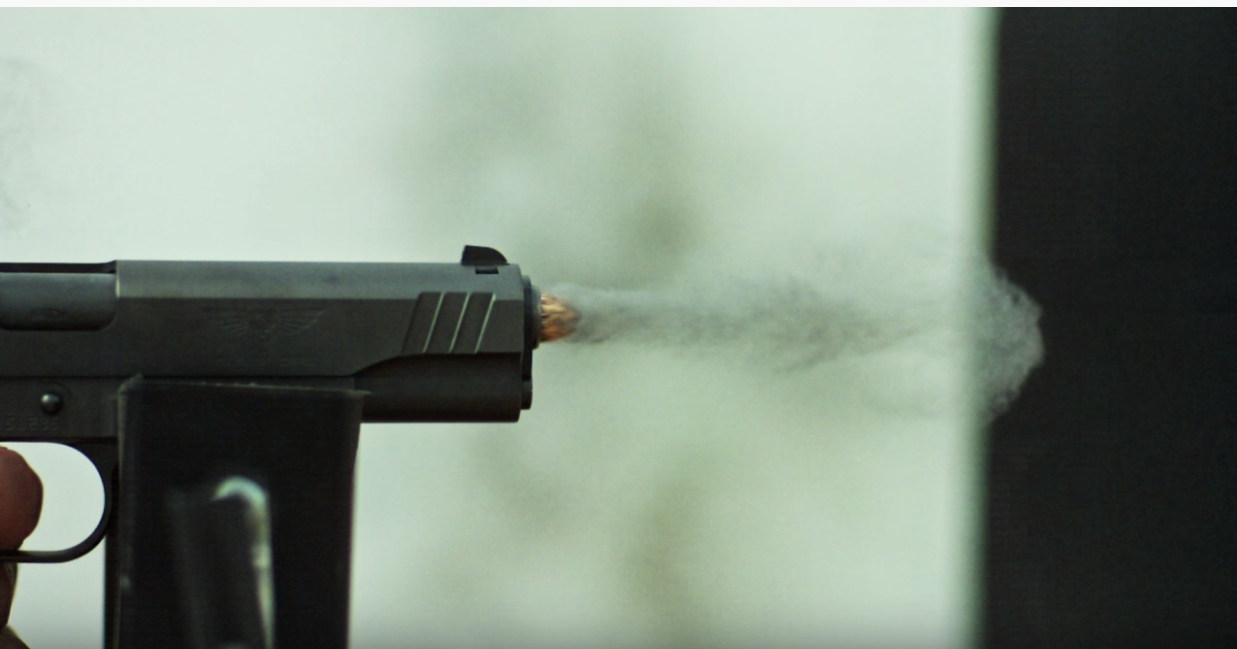
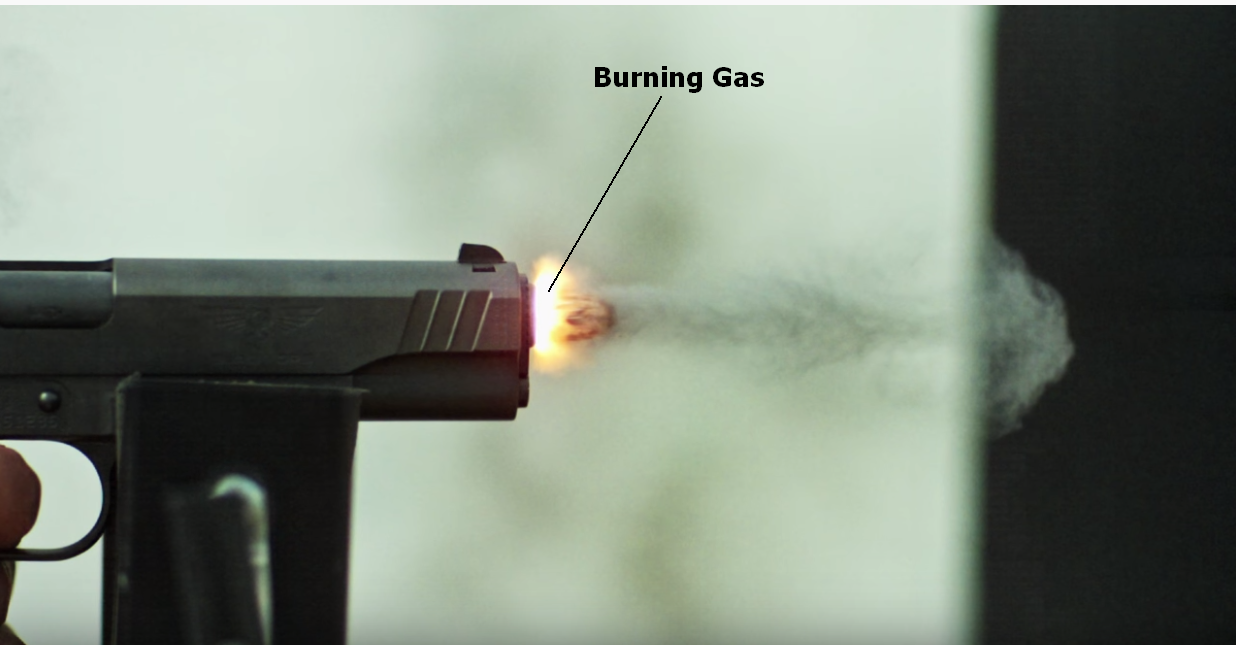
Hot, burning, expanding gas explodes out of the barrel around the bullet. This hot gas accelerating out of the muzzle imparts an equal and opposite force to the pistol as "Jet Effect" recoil.
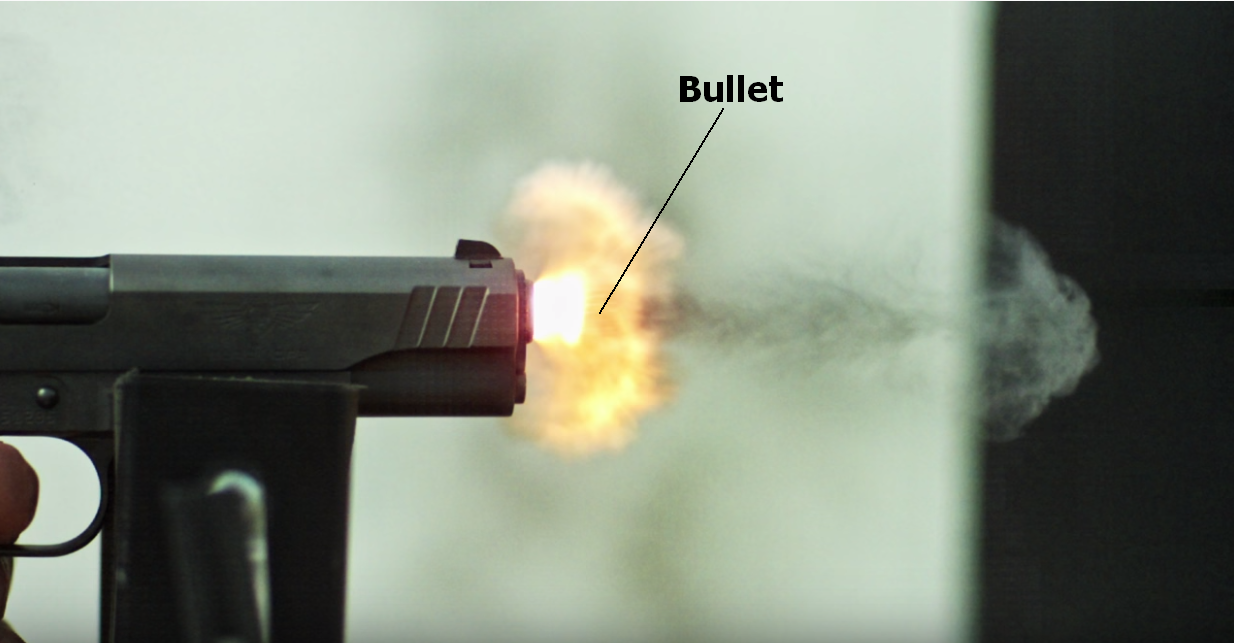
Note how the bullet is clear of the barrel and the slide has moved rearward less than 1/10th of an inch.
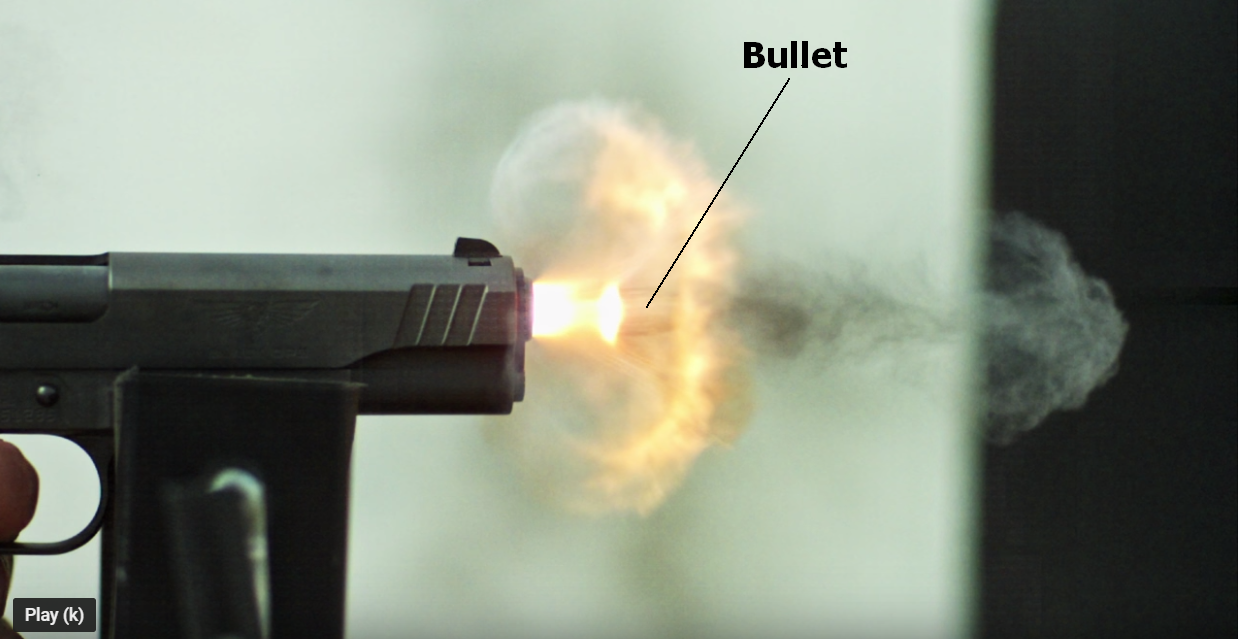
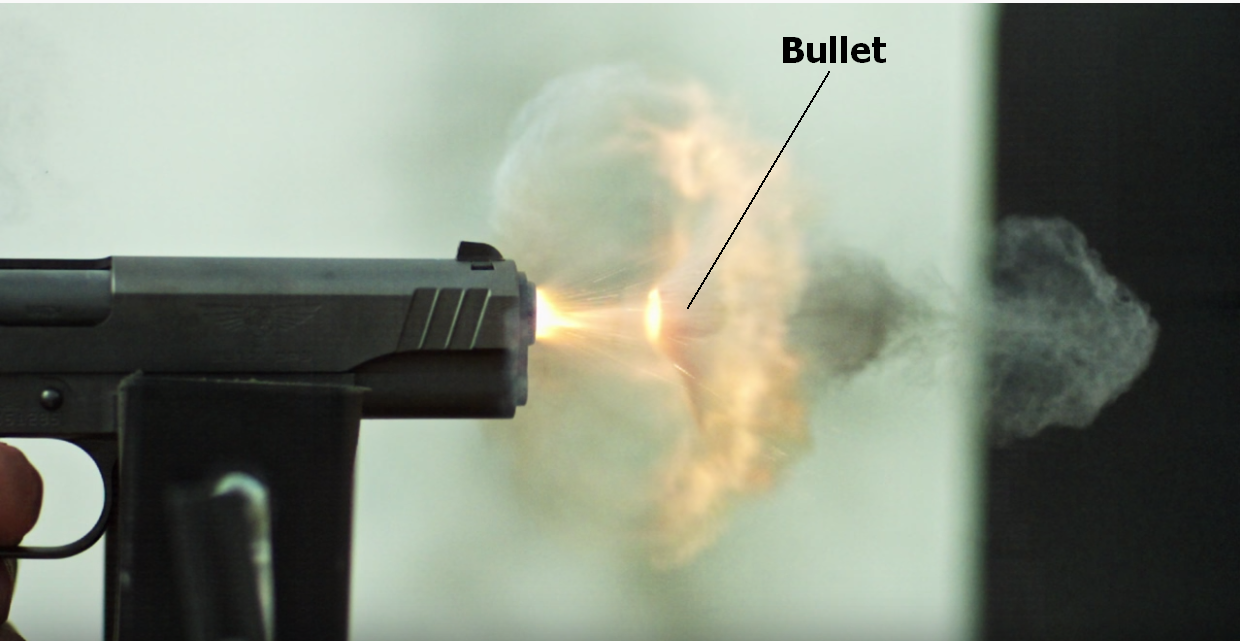
Note how jet effect gas hits the base of the bullet and shoots outward at 90 degrees. This gas is moving much faster than the bullet and is on average 1.7 times faster than bullet muzzle velocity. Even after the bullet clears the barrel, gas continues to push the bullet for about 15 bullet diameters (calibers) downrange which equals 6.75 inches with this 45 pistol. This is why the shape of the bullet base or boat tail can have an effect on accuracy.
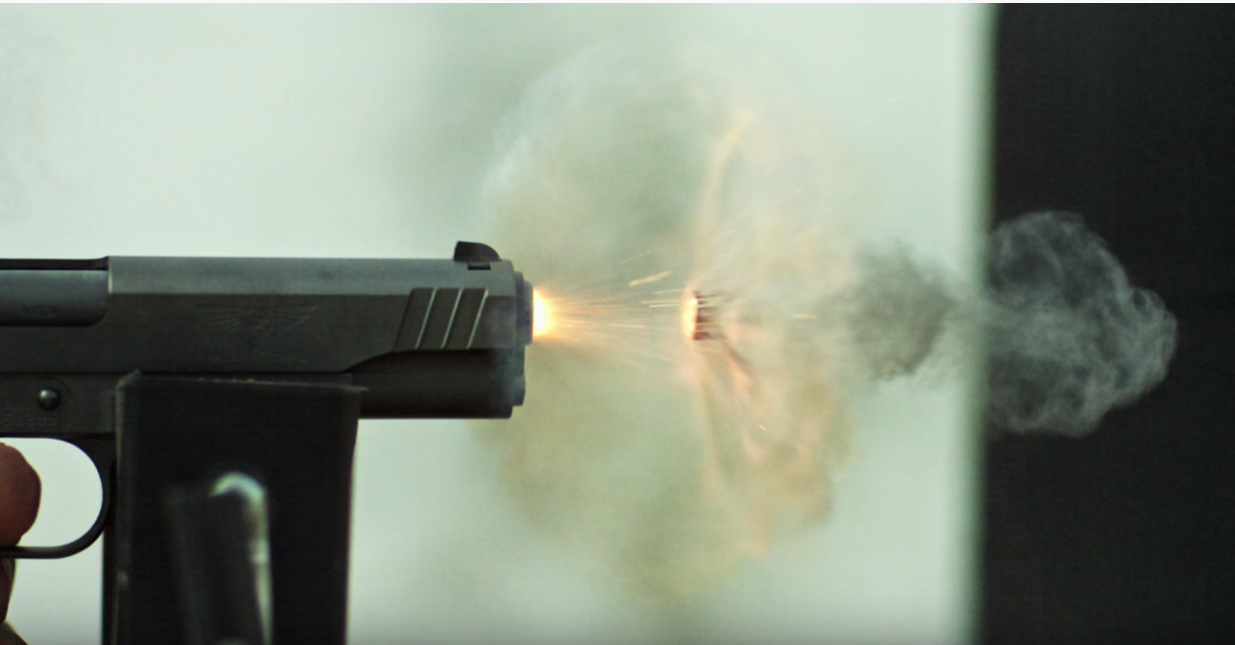
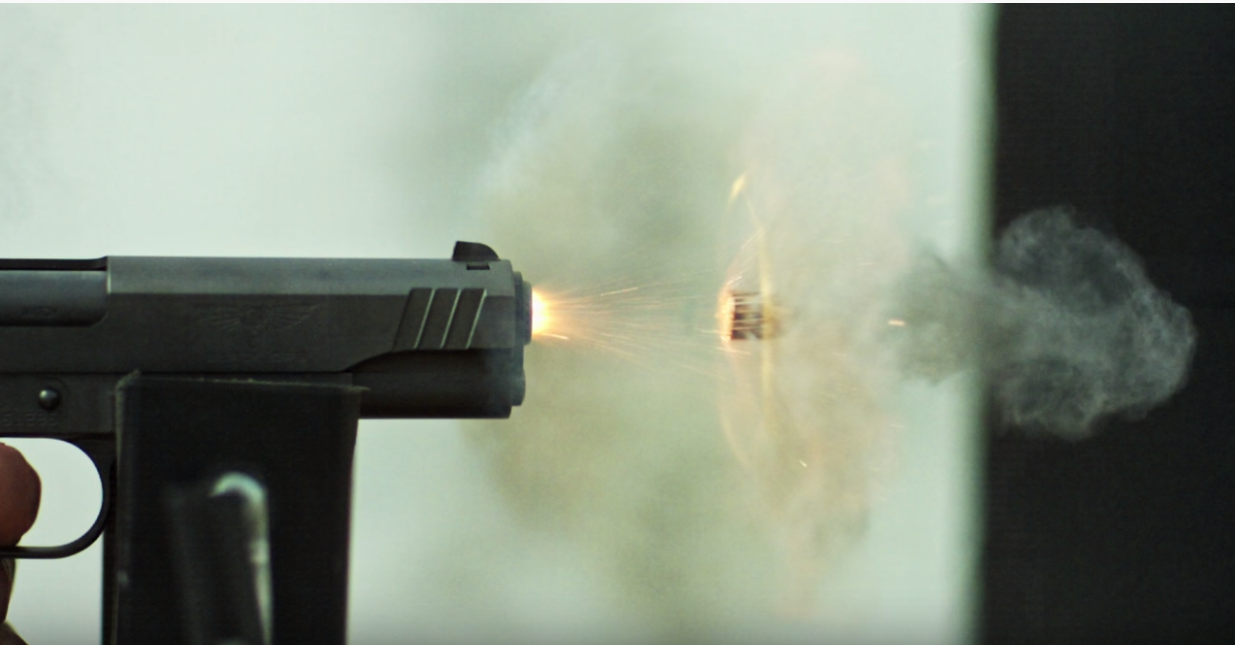
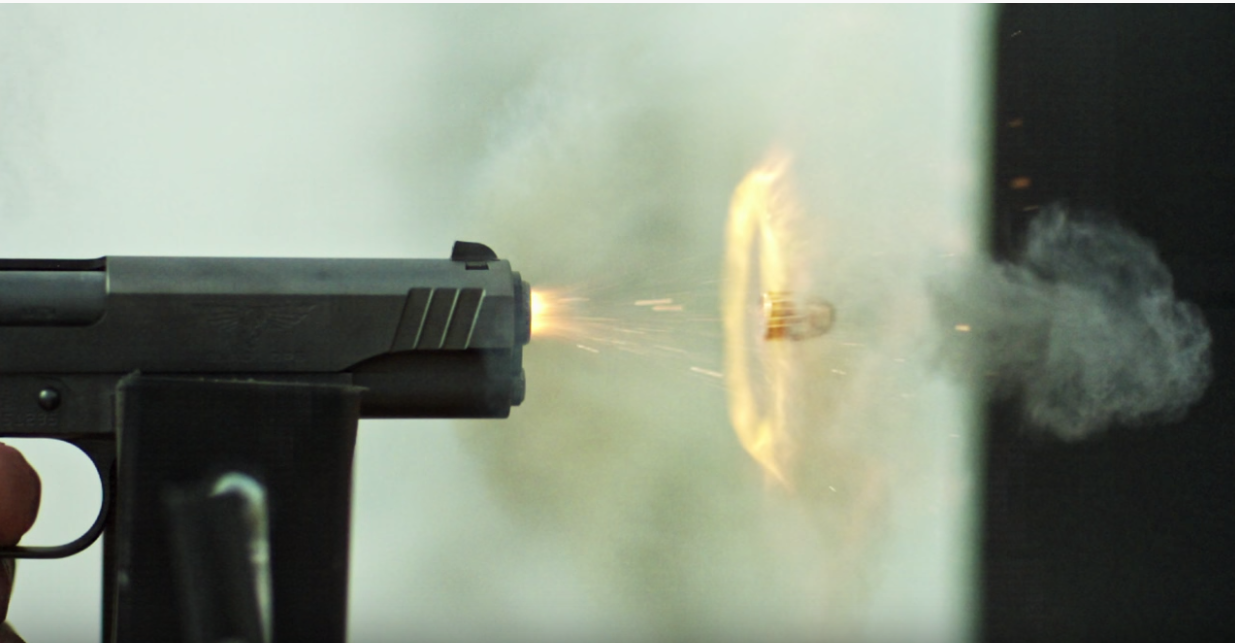
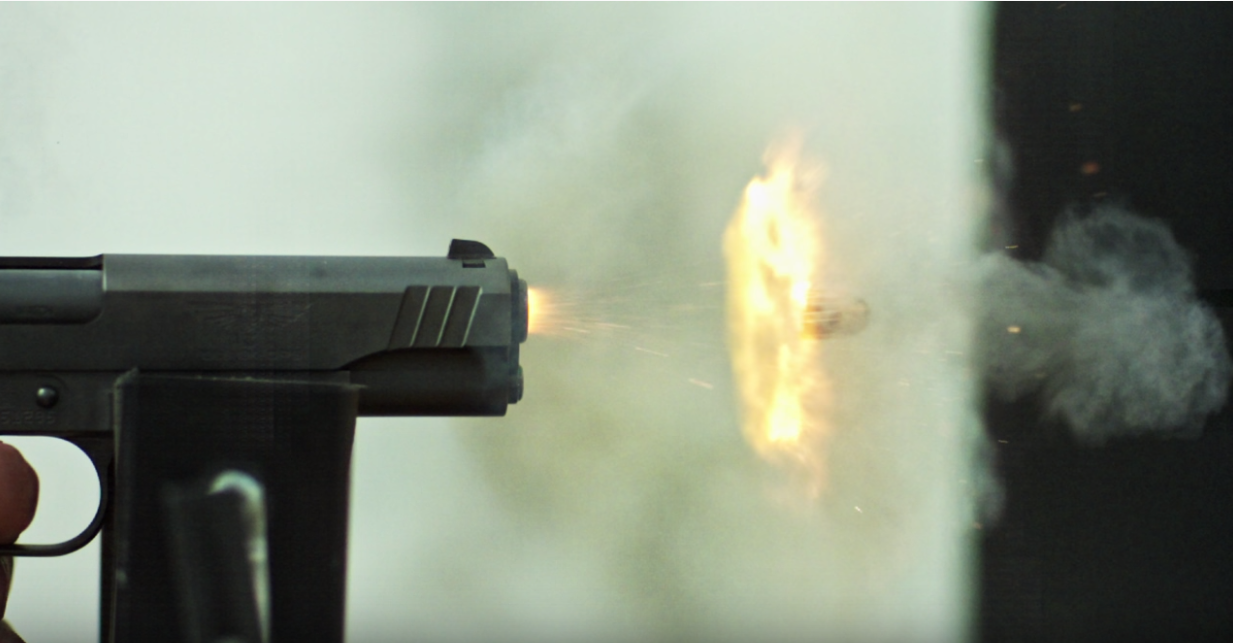

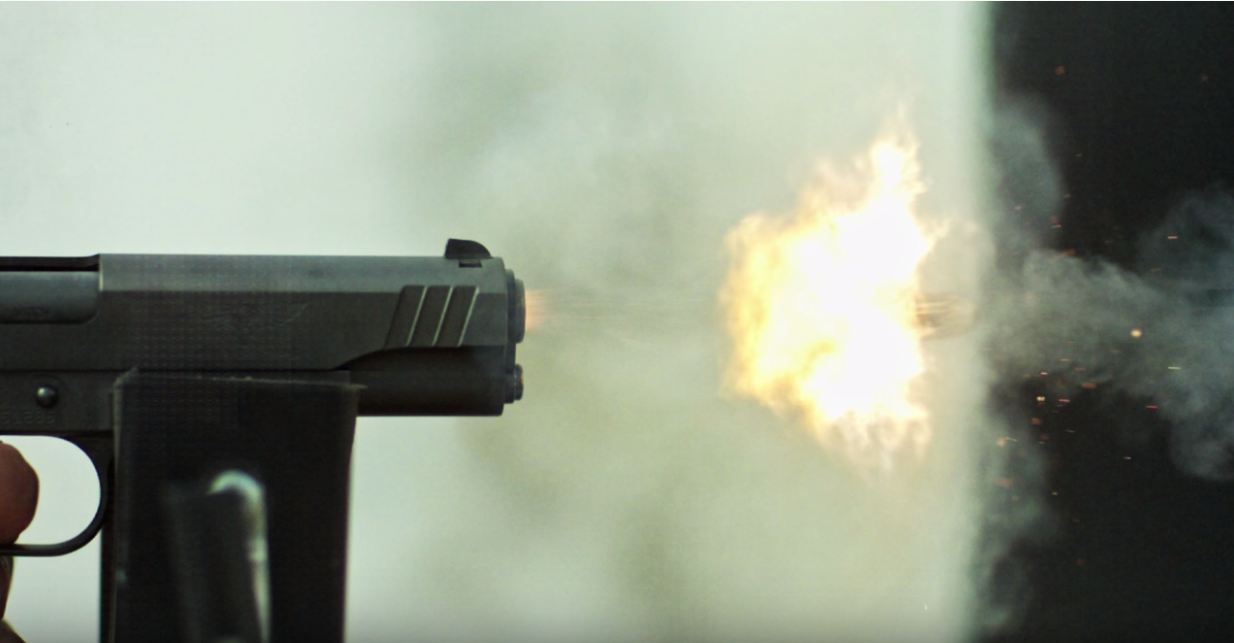
This flame outside the barrel represents gas expansion that did not occur in the barrel, and did not propel the bullet, or generate gas recoil or jet effect recoil. A faster burning powder would be more efficient.
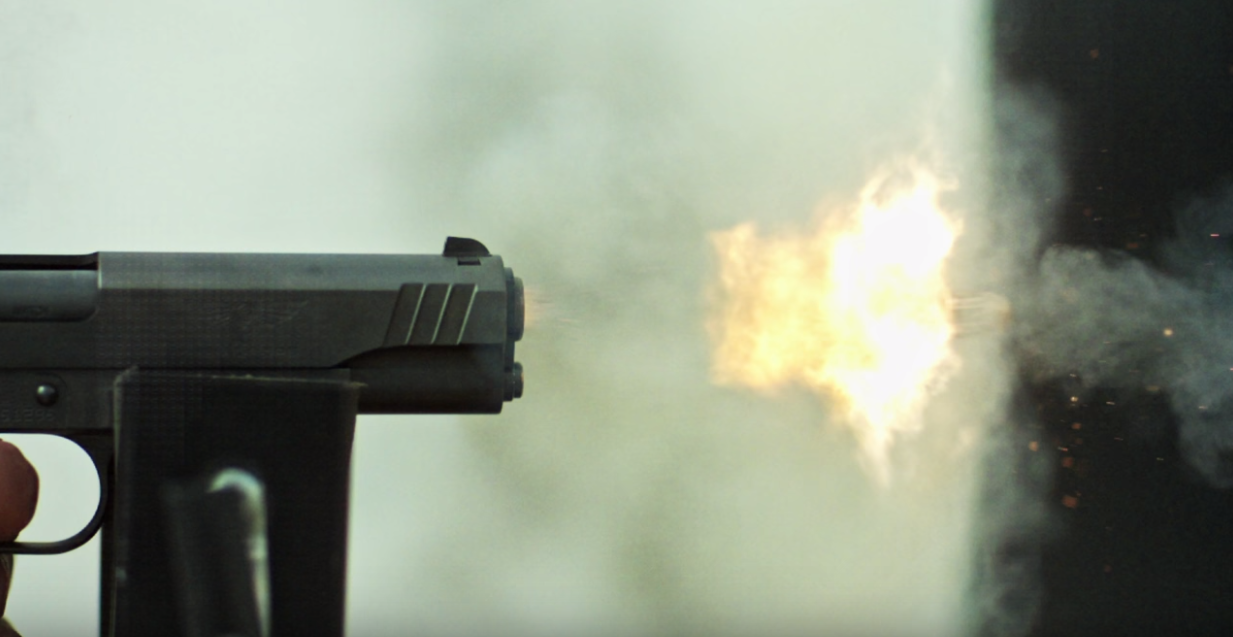
Jet effect gasses continue to push the bullet until it gets approximately 15 bullet diameters (calibers) from the muzzle. For this .45 caliber we get: .45 * 15 = 6.75 inches.
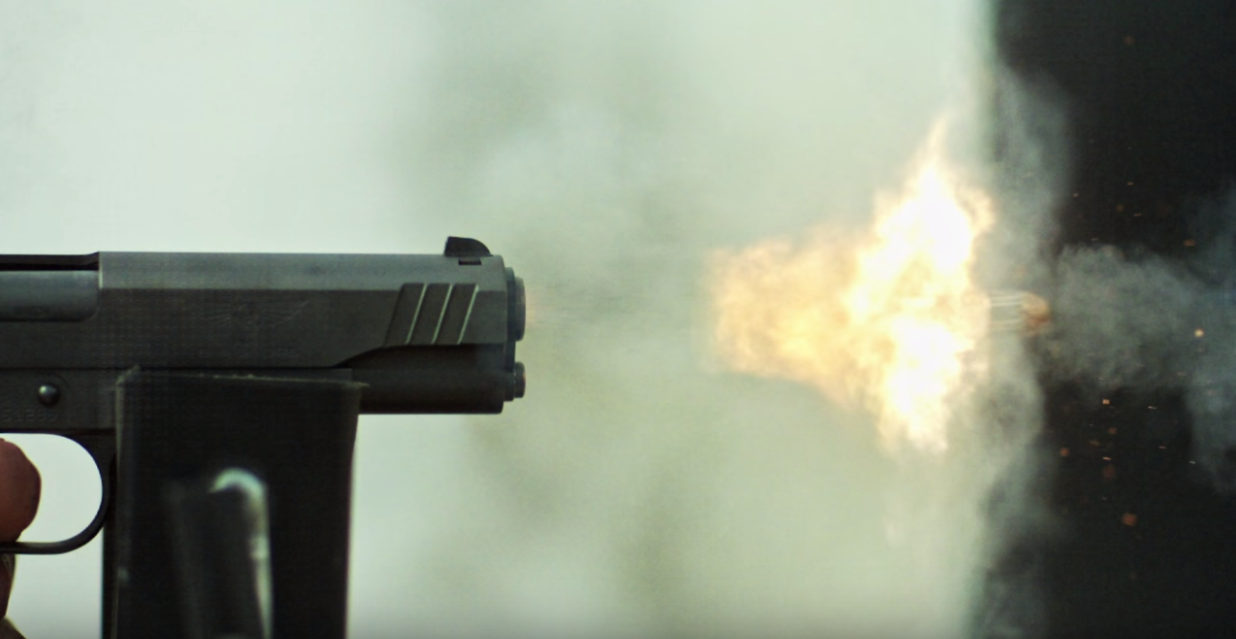
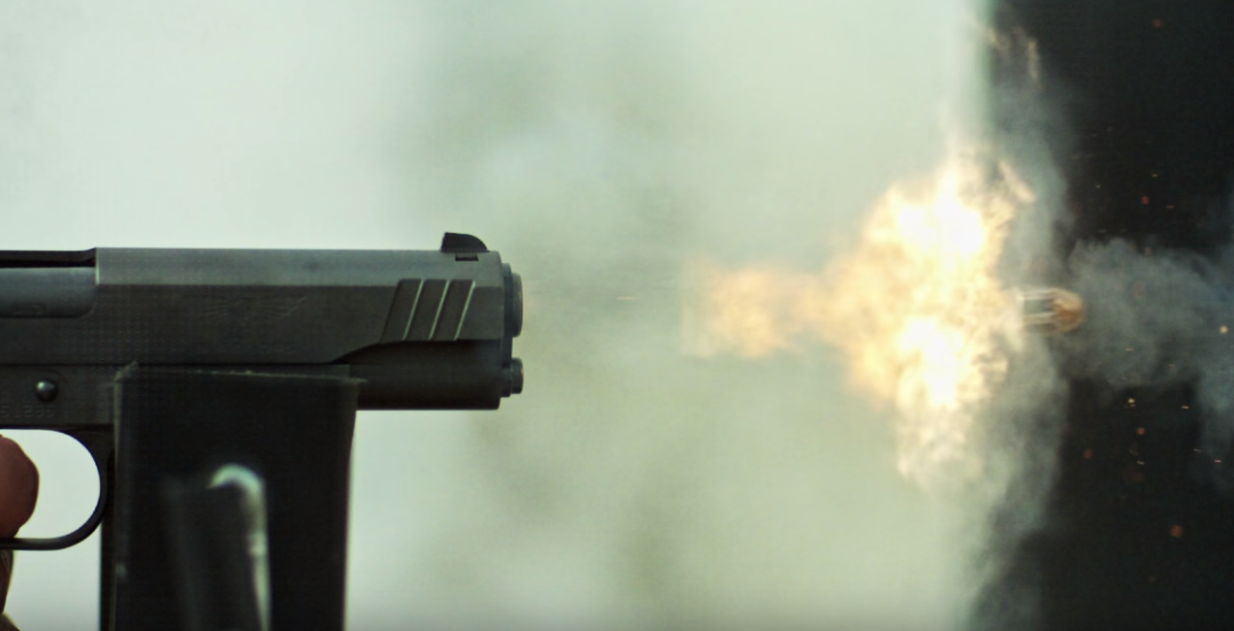
9mm


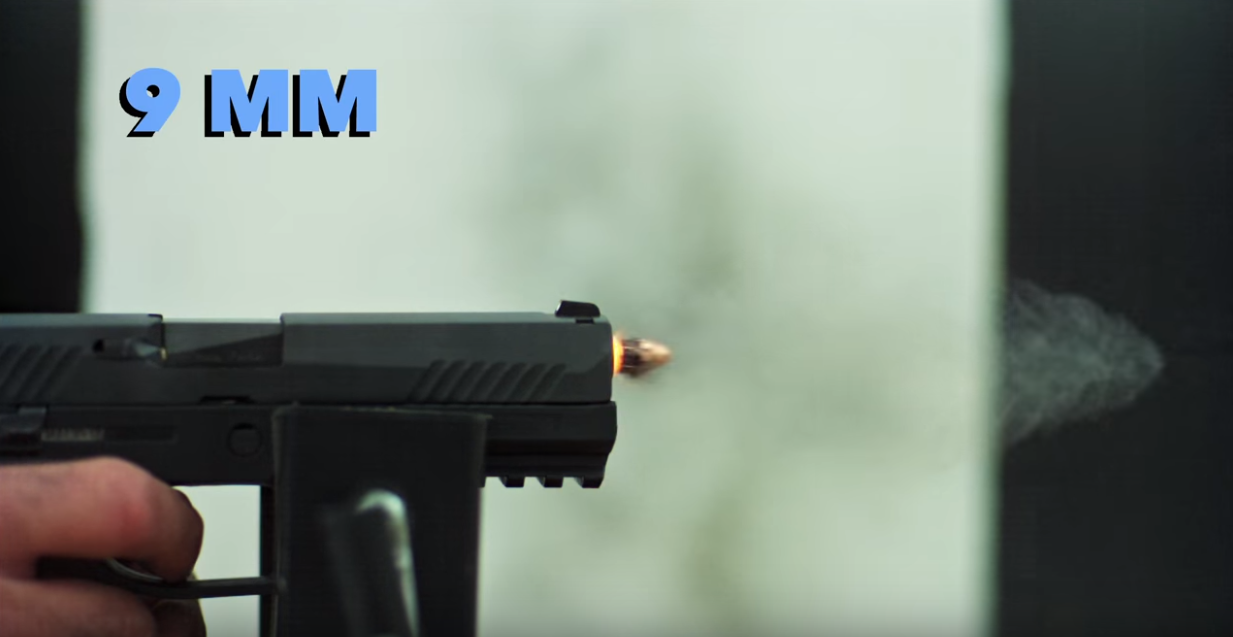
Note how the bullet is clear of the barrel and the slide has moved rearward less than 1/10th of an inch.
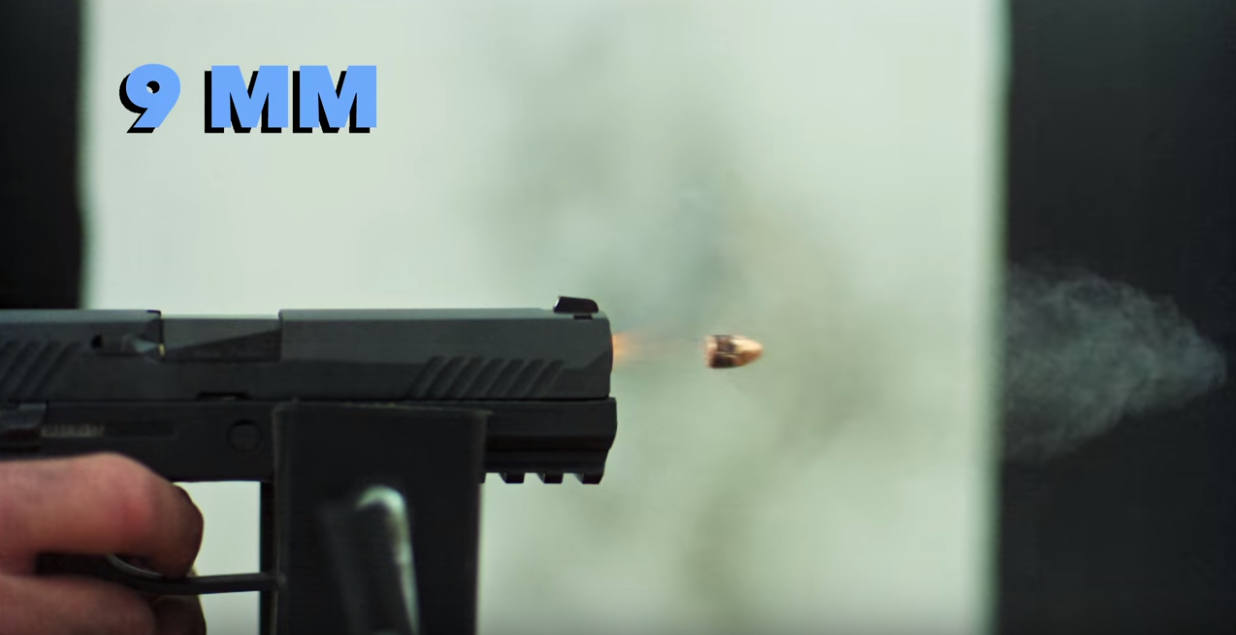
Compare this 9mm muzzle flame to the 45ACP above. This powder burned quickly and efficiently inside the barrel.
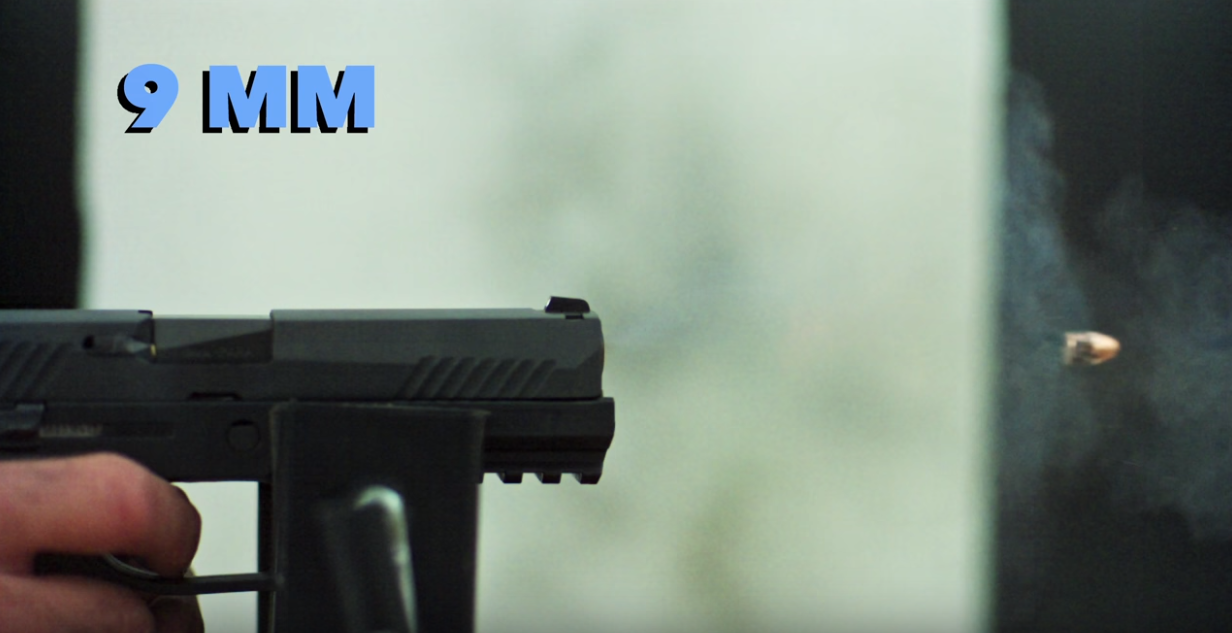
Another Video of Super Slow Motion Bullet Muzzle Exit
Be sure and watch the revolver shot at the end of the video.
By Major Rob Robinette
US Army and Air Force (Retired)
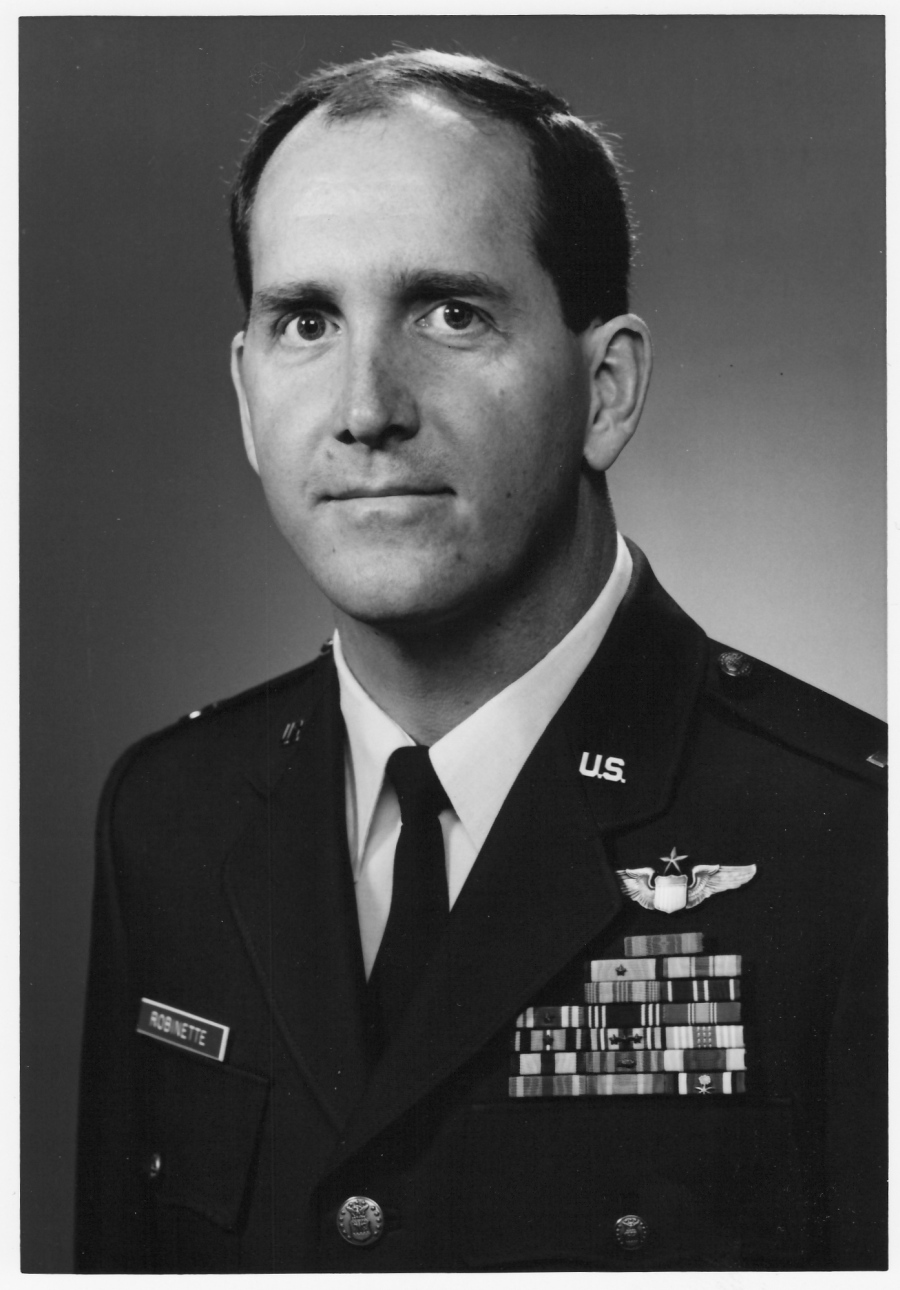
Major Robinette was a Battalion Marksmanship Champion, Squadron Rifle Team Captain and Range Officer. Rob also spent 10 years as a federal law enforcement officer. He held a Federal Firearms License and was the owner of Nolichucky Guns. He enjoys all forms of rifle and pistol use.
